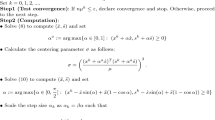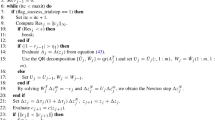Abstract
This paper concerns about the possibility of identifying the active set in a noninterior continuation method for solving the standard linear complementarity problem based on the algorithm and theory presented by Burke and Xu (J. Optim. Theory Appl. 112 (2002) 53). It is shown that under the assumptions of P-matrix and nondegeneracy, the algorithm requires at most Oρlog(β0μ0/τ)) iterations to find the optimal active set, where β0 is the width of the neighborhood which depends on the initial point, μ0> 0 is the initial smoothing parameter, ρ is a positive number which depends on the problem and the initial point, and τ is a small positive number which depends only on the problem.
Similar content being viewed by others
References
Burke, J. and Xu, S. (1998), The global linear convergence of a non-interior path-following algorithm for linear complementarity problem, Math. Opera. Research 23, 719-734.
Burke, J. and Xu, S. (2000), A non-interior predictor-corrector path following algorithm for the monotone linear complementarity problem, Math. Programming 87, 113-130.
Burke, J. and Xu, S. (2002), Complexity of a noninterior path-following method for the linear complementarity problem, J. Optim. Theory Appl. 112, 53-76.
Chen, B. and Chen, X. (2000), A global linear and local quadratic continuation smoothing method for variational inequalities with box constraints, Compu. Optim. Appl. 17, 131-158.
Chen, B. and Chen, X. (1999), A global and local superlinear continuation-smoothing method for P0 + R0 and monotone NCP, SIAM J. Optimization 9, 624-645.
Chen, B. and Harker, P.T. (1993), A non-interior-point continuation method for linear complementarity problems, SIAM J. Matrix Anal. Appl. 14, 1168-1190.
Chen, B. and Harker, P.T. (1997), Smoothing approximations to nonlinear complementarity problems, SIAM J. Optim. 7, 403-420.
Chen, B. and Xiu, N. (1999), A global linear and local quadratic non-interior continuation method for nonlinear complementarity problems based on Chen-Mangasarian smoothing functions, SIAM J. Optimization, 9, 605-623.
Chen, B. and Xiu, N. (2001), Superlinear noninterior one-step continuation method for monotone LCP in the absence of strict complementarity, J. Optim. Theory Appl. 108, 317-332.
Chen, C.H. and Mangasarian, O.L. (1995), Smoothing methods for convex inequalities and linear complementarity problems, Math. Programming 71, 51-69.
Chen, C.H. and Mangasarian, O.L. (1996), A class of smoothing functions for nonlinear and mixed complementarity problems, Computational Optim. and Appl. 5, 97-138.
Chen, X., Qi, L. and Sun, D. (1998), Global and superlinear convergence of the smoothing Newton method and its application to general box constrained variational inequalities, Math. Compu. 67, 519-540.
Chen, X. and Ye, Y. (1999), On homotopy-smoothing methods for variational inequalities, SIAM J. Control and Optimization, 37, 589-616.
Cottle, R.W., Pang, J.S. and Stone, R.E. (1992), The Linear Complementarity Problem, Academic Press, New York.
El-Bakry, A.S., Tapia, R.A. and Zhang, Y. (1994), A study of indicator for identifying zero variables in interior-point methods, SIAM Rev. 36, 45-72.
Facchinei, F., Fischer, A. and Kanzow, C. (1999), On the accurate identification of active constraints, SIAM J. Optimization 9, 14-32.
Facchinei, F., Fischer, A. and Kanzow, C. (2000), On the identification of zero variables in an interior-point framework, SIAM J. Optimization 10, 1058-1078.
Facchinei, F. and Kanzow, C. (1999), Beyond monotonicity in regularization methods for nonlinear complementarity problems, SIAM J. Control Optim., 37, 1150-1161.
Ferris, M.C. and Kanzow, C. (2000), Complementarity and related problems. In: Pardalos, P.M. and Resende, M.G.C. (eds.), Handbook on Applied Optimization, Oxford University Press, Oxford, UK.
Fukushima, M., Luo, Z.Q. and Pang, J.S. (1998), A globally convergent sequential quadratic programming algorithm for mathematical programs with linear complementarity constraints, Compu. Optim. Appl. 10, 5-34.
Gabriel, S.A. and Moré, J.J. (1996), Smoothing of mixed complementarity problems. In: Ferris, M.C. and Pang, J.S. (eds.), Complementarity and Variational Problems: State of the Art, SIAM, Philadelphia, PA, pp. 105-116.
Gowda, M.S. and Tawhid, M.A. (1999), Existence and limiting behavior of trajectories associated with P0-equations, Compu. Optim. Appl. 12, 229-251.
Hotta, K. and Yoshise, A. (1999), Global convergence of a class of non-interior-point algorithm using Chen-Harker-Kanzow functions for nonlinear complementarity problems, Math. Programming, 86, 105-133.
Hotta, K., Inaba, M. and Yoshise, A. (2000), A complexity analysis of a smoothing method using CHKS-functions for monotone linear complementarity problems, Compu. Optim. Appl. 17, 183-201.
Illé, T., Peng, J., Roos, C. and Terlaky, T. (2000), A strongly polynomial rounding procedure yielding a maximally complementary solution for P *(κ) linear complementarity problem, SIAM J. Optimization 11, 320-340.
Kanzow, C. (1996), Some noninterior continuation methods for linear complementarity problems, SIAM J. Matrix Analysis and Applications, 17, 851-868.
Kanzow, C. and Pieper, H. (1999), Jacobian smoothing methods for general nonlinear complementarity problems, SIAM J. Optimization, 9, 342–372.
Mathias, R. (1989), An improved bound for a fundamental constant associated with a P-matrix, Appl. Math. Letters 2, 297-300.
Mathias, R. and Pang, J.S. (1990), Error bounds for the linear complementarity problem with a P-matrix, Linear Algebra Appl. 132, 123-136.
Peng, J.M. and Lin, Z. (1999), A noninterior continuation method for generalized linear complementarity problems, Math. Programming, 86, 533-563.
Qi, H.D. (2000), A regularized smoothing Newton method for box constrained variational inequality problems with P0 functions, SIAM J. Optimization, 10 315–330.
Qi, H.D. and Liao, L. (1999), A smoothing Newton method for extended vertical linear complementarity problems, SIAM J. Matrix Anal. Appl. 21, 45-66.
Qi, L. and Sun, D. (2000), Improving the convergence of non-interior point algorithms for nonlinear complementarity problems, Mathematics of Computation, 69, 283-304.
Qi, L. and Sun, D. Smoothing functions and a smoothing Newton method for complementarity and variational inequality problems, J. Optim. Theory Appl., to appear.
Qi, L. and Sun, D. (1999), Nonsmooth equations and smoothing methods. In: Eberhard, A., Glover, B., Hill, R. and Ralph, D. (eds), Progress in Optimization: Contributions from Australasia, Kluwer Academic Publishers, Nowell, MA.
Qi, L., Sun, D. and Zhou, G. (2000), A new look at smoothing Newton methods for nonlinear complementarity problems and box constrained variational inequalities, Math. Programming 87, 1-35.
Ravindran, G. and Gowda, M.S. (2000), Regularization of P0-functions in box variational inequality problems, SIAM J. Optimization, 11, 748-760.
Sun, D. (1999), A regularization Newton method for solving nonlinear complementarity problems, Appl. Math. Optim., 40, 315-339.
Tseng, P. (1998), Analysis of a non-interior continuation method based on Chen-Mangasarian smoothing functions for complementarity problems. In: Fukushima, M. and Qi, L. (eds.), Reformulation-Nonsmooth, Piecewise Smooth, Semismooth and Smoothing Methods, Kluwer Academic Publishers, Nowell, MD, pp. 381-404.
Zhou, G., Sun, D. and Qi, L. (1998), Numerical experiments for a class of squared smoothing Newton methods for complementarity and variational inequality problems. In: Fukushima, M. and Qi, L. (eds.), Reformulation-Nonsmooth, Piecewise Smooth, Semismooth and Smoothing Methods, Kluwer Academic Publishers, Nowell, MD, pp. 421-441.
Author information
Authors and Affiliations
Rights and permissions
About this article
Cite this article
Xiu, N., Zhang, J. Identification of the Optimal Active Set in a Noninterior Continuation Method for LCP. Journal of Global Optimization 26, 183–198 (2003). https://doi.org/10.1023/A:1023065422836
Issue Date:
DOI: https://doi.org/10.1023/A:1023065422836




